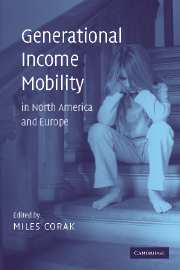Book contents
- Frontmatter
- Contents
- List of figures
- List of tables
- List of contributors
- Preface
- 1 Generational income mobility in North America and Europe: an introduction
- 2 A model of intergenerational mobility variation over time and place
- 3 Equal opportunity and intergenerational mobility: going beyond intergenerational income transition matrices
- 4 Intergenerational mobility for whom? The experience of high- and low-earning sons in international perspective
- 5 What do trends in the intergenerational economic mobility of sons and daughters in the United States mean?
- 6 Changes in intergenerational mobility in Britain
- 7 Intergenerational mobility in Britain: new evidence from the British Household Panel Survey
- 8 Non-linear patterns of intergenerational mobility in Germany and the United States
- 9 Family structure and labor market success: the influence of siblings and birth order on the earnings of young adults in Norway, Finland, and Sweden
- 10 New evidence on the intergenerational correlation in welfare participation
- 11 Intergenerational influences on the receipt of unemployment insurance in Canada and Sweden
- 12 Unequal opportunities and the mechanisms of social inheritance
- Index
- References
9 - Family structure and labor market success: the influence of siblings and birth order on the earnings of young adults in Norway, Finland, and Sweden
Published online by Cambridge University Press: 22 September 2009
- Frontmatter
- Contents
- List of figures
- List of tables
- List of contributors
- Preface
- 1 Generational income mobility in North America and Europe: an introduction
- 2 A model of intergenerational mobility variation over time and place
- 3 Equal opportunity and intergenerational mobility: going beyond intergenerational income transition matrices
- 4 Intergenerational mobility for whom? The experience of high- and low-earning sons in international perspective
- 5 What do trends in the intergenerational economic mobility of sons and daughters in the United States mean?
- 6 Changes in intergenerational mobility in Britain
- 7 Intergenerational mobility in Britain: new evidence from the British Household Panel Survey
- 8 Non-linear patterns of intergenerational mobility in Germany and the United States
- 9 Family structure and labor market success: the influence of siblings and birth order on the earnings of young adults in Norway, Finland, and Sweden
- 10 New evidence on the intergenerational correlation in welfare participation
- 11 Intergenerational influences on the receipt of unemployment insurance in Canada and Sweden
- 12 Unequal opportunities and the mechanisms of social inheritance
- Index
- References
Summary
The last ten years have seen an upsurge in research on intergenerational earnings and income mobility. A good deal has been learned about this topic, as witnessed in the survey by Solon (1999), the collection of papers published in the 2002 volume of the Journal of Economic Perspectives, as well as the chapters of this book. On the methodological side, empirical researchers are now much better equipped with data and techniques to avoid various biases that plagued earlier attempts to estimate parent–offspring and siblings correlations in long-run earnings. Further, the order of magnitude of father–son elasticities and brother correlations has been established with some degree of confidence in a number of countries. Nonetheless, it is almost an understatement to claim that much more needs to be learnt before analysts can claim to have uncovered the mechanisms that generate these relationships and how various policies could affect them.
There are different opinions about how research on intergenerational mobility should best proceed. A theorist could complain about the lack of a theoretical underpinning in much empirical research published since the early 1990s. A more empirically oriented researcher could argue that natural experiments generating useful exogenous information should be identified and used so that truly causal mechanisms can be identified. Most likely there is much room for both these approaches. The goal of the research reported in this chapter, however, is different and in a sense quite modest.
- Type
- Chapter
- Information
- Generational Income Mobility in North America and Europe , pp. 207 - 225Publisher: Cambridge University PressPrint publication year: 2004
References
- 11
- Cited by



